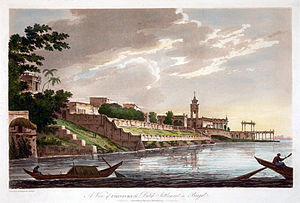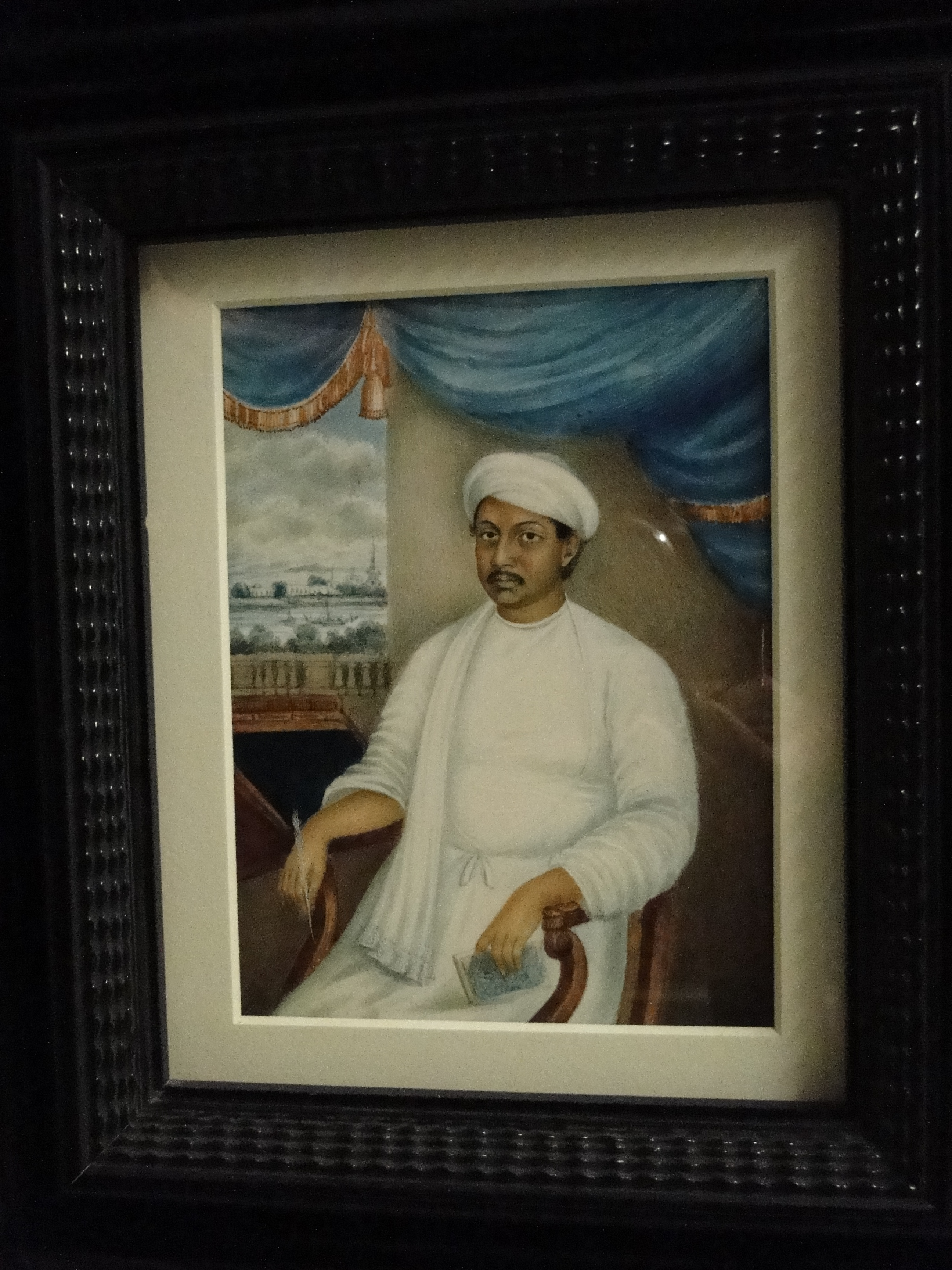In my post of Nov 12, 2012, I wrote about a letter that revealed to me that Benjam Burnham, a character in Sea of Poppies and River of Smoke, had a real life counterpart (the letter was actually from one of his descendants). Even stranger, I later found out that my wife had been taught by a member of this family, and that my son had been to school with another. Synchronicity is a mysterious thing…
On April 21, this year I received a message about another character in the Ibis Trilogy– Neel Rattan Halder, the Raja of Raskhali and originator of the Ibis Chrestomathy. This message prompted the correspondence that is posted below.
Dear Amitav Sir,
It is refreshing, as is always for a regular reader of your blog, to know about your encounter with Mr Mohammad Hossein Mohammadi. What strikes me most profoundly in your article is the fact that the content of Mr Mohammadi’s writings mostly highlight the daily lives of Afghan society, something beyond the widely held stereotype of the country surrounding its wars. It actually reminds me of a lecture by Nigerian novelist Chimamanda Ngozi Adichie, titled ‘the danger of a single story’ that I listened online in Youtube. That talk also addressed the futility and limitations imposed by literary or artistic stereotypes. I am not fortunate enough so far to have read one of Mr Mohammdi’s writings but I will definitely make an effort to do so in future.
I wish to mention to you about one more thing. Our last and only communication before this was in October 2011. I am currently pursuing Pediatric residency training in Flushing Hospital, Queens, New York. I came across one article written in Bengali by our family physician and local historian, Shri (Dr) Akshay Kumar Adhaya, which explores the connection between Prankrishna Halder (Neel’s real life shadow) and my hometown,

Chinsura on the river Hooghly, which also serves as a source of Neel’s finest cotton dhotis in Sea of Poppies.
The article even traces Prankrishna’s connection to Hooghly Collegiate School, where I studied for a decade. I thought the article might interest you. Unfortunately, the article comes only as a hard copy. If you can please tell me how to send you a copy (I could try to scan it if you find it appropriate) of that article, I shall be extremely grateful.
Naboborsher pronam.
Suhas
April 23
Dear Suhas
Thanks very much for the link which I will listen to when possible.
What you say about Dr Adhya’s article is very interesting. It would be wonderful if you could scan the article for me – I am traveling now so a hard copy would not reach me anyway.
Thanks and all best
Amitav Ghosh
April 29
Dear Amitav Sir,
I apologize for the delay in my response. I took some time in scanning Dr Adhya’s article as I got caught up with my On Call schedule. Attached are the pages of the article.
I found it an interesting coincidence that Prankrishna Halder did have a real life nephew named Neel Ratan Halder, who was known to be an exponent of music, contemporary literature and a lover of art.
My Alma mater, Hooghly Collegiate School, was also probably part of Prankrishna’s real estate in Chinsurah.
According to unproven local legend, fake currency notes used to be printed in a room that went on to become the classroom for class six.
Please let me know if you have any inconvenience in viewing the article.
Thank you so much for your time and your encouragement to write to you.
much regards,
Suhas
This letter was accompanied by a scan of eight pages from Dr. Akshaykumar Adhya’s book Hooghly Chuchurar Nana Katha (Various Facts about Hooghly Chinsurah) volume-1, pages: 128-134 (publisher: Hooghly Sambad, Dr Prasad Das Mallick Road, Hooghly-712103, third reprint; November 2010).

The pages tell the story of one Babu Prankrishna Haldar a rich Bengali who acquired a very large house in the town of Chinsurah (Chuchura) near Calcutta (now Kolkata) in 1805 C.E..
The house was built by General Perron, military advisor to Madhoji Scindia, who was returning to Europe. The mansion, which now houses the Hooghly Collegiate School, became famous because of Prankrishna Haldar’s family temple, which was located in the compound. For many years Prankrishna Haldar celebrated Durga Puja in this temple at great expense: these events were advertised in Bengali papers and in the Calcutta Gazette.
In 1827 Samachar Darpan (which is considered by some to be the first printed journal in an Indian language) published an article about Prankrishna Haldar’s generosity, mentioning particularly his donations of medicine to the poor. But Prankrishna Haldar’s liberality was to prove his undoing for his philanthropic ambitions forced him to resort to fraud and forgery. He began to print counterfeit notes in a secret corner of the mansion. Through these means he amassed 60 lakh rupees.
The crime was discovered in 1829 and Prankrishna Haldar was sentenced to imprisonment. He was released in 1836 and died the year after. After his death, the writer Durgacharan Ray observed: ‘Prankrishna enjoyed all the rewards that life offered; all the sorrows that a man could suffer also fell to his lot.’
Also sentenced with Prankrishna Haldar was an associate and relative, Babu Nilmoni Haldar, who had assisted in the forgery. Babu Nilmoni Halder was a cultivated man and a supporter of learning, who had set up a press at a time when Bengali printing was in its infancy. He died in 1837.
Babu Nilmoni Haldar had a son by the name of Neelratan Haldar who became a noted literary figure.

He was described by Rajnarayan Bose, the eminent 19th century writer and philosopher, as a man of impressive physical presence who knew many languages and was a conoisseur of classical music.
Neelratan Haldar probably acquired his love of learning from his father, and went on to publish several books on diverse subjects. But he was best known as the editor and publisher of the journal Bangadoot, the first issue of which was published on May 10, 1829. He died in 1855.
May 3
Dear Suhas
Thank you very much indeed for this article. It is very interesting.
Would you mind if I posted our correspondence on my blog, along with a few translated excerpts of the article? Please do let me know.
With my best wishes
Amitav
May 3
Dear Amitav Sir,
I am very happy to know that the article interests you. I am extremely thrilled at the possibility of our correspondence finding its way to your prestigious blog along with the translated excerpts.
Incidentally, I had a conversation with Dr Akshay Adhya over phone this evening, when I mentioned to him about our correspondence. He has expressed that he is excited about your interest in his article.
joyous regards,
Suhas
May 7
Dear Suhas
Could you please send me the exact references of the journal where the article was published so that I can include it in my post?
Thanks
Amitav
May 8
Dear Amitav Sir,
I am enclosing the cover of the book with my mail.
Interestingly, the cover picture
features a notable landmark in the outskirts of the town-Susanna Anna Marie tomb, or ‘Saat Saheber Bibir Ghor’. It is a memorial of a lady who is said to have had seven husbands, all of whom had died before her. Her chronicle inspired a short story (later made into a novel) called ‘Susanna’s Seven Husbands’ by Ruskin Bond and was adapted for a major Hindi Commercial Motion Picture ‘Saat Khoon Maaf’ by Vishal Bharadwaj.
I apologize for my delay,
Thanks for your patience and time once again.
Much regards,
Suhas
Dear Suhas
Thanks for your message. I will post the piece today.
Unfortunately the scan was very blurred and I had trouble reading it. However, I have tried to convey the gist of it. I would be glad to post a more detailed translation if you could send me one.
I also could not find a nice image of Prankrishna Haldar’s mansion but I have included a picture of the gate.
Thanks once again for this interesting exchange.
With my best wishes
Amitav
[A Google search for ‘Prawn Kissin Halder’ (the 19th century anglice of ‘Prankrishna Haldar’) led me to an interesting paper by Rashmila Maity ‘From Kidderpore to The Sea of Poppies: A short history of some localities in the novel.’ A search for ‘Prankrishna Haldar’ led to this charming clip on You Tube.]



Thank you for mentioning my paper Sir! This has made my day.
Hello Ms. Maiti and Mr. Ghosh,
Would it be possible to access this paper on localities in ‘Sea of Poppies’? I’m a huge fan of everything Ghosh, and I enjoy following up on the historical underpinnings of the writings. This sounds delightful.
Thank you for your consideration,
Lorie
Dear Mr Amitav Ghosh,
I found this link which cites ‘Sea of Poppies’ and Raja of Rashkhali and it has been cited in context of religious teachings. I thought this might interest you.
http://www.saintmarksphiladelphia.org/sermons/2011/2/21/raja-of-rashkali.html
Regards,
Kalpasree
Dear Kalpasree
Thank you very much for this! It is so surprising – a beautiful sermon.
Best wishes
Amitav
I have read Hooghly Chuchurar Nana Katha earlier but failed to see the connection between the novel and the story of PranKrishna Halder. Thank you Suhas and Amitav Sir for this interesting communication. It inspired me to read the book again.
Amitav Sir, if you want the scanned copy of the pages again I can send it to you and also some pictures of the mansion as I live quite close to it.
Dear Samrat
It would be nice to have some pictures, but no hurry.
thanks
AG
Am from Chinsura and student of Hoogly Collegiate Schoo and Hogly Mohsin College.Heard from my grandfather that Sri Prankrishna Halder was Residing in the building in front of our schoo and the school was his Pujamandap which was our classroom.He was tortured by Englishmen for reportedly challangeing them. As I am interested in old history of my town like the article